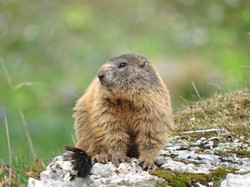Mammal’s response to environmental changes
Today's rate of biodiversity loss is one thousand times higher than historical rates of extinction. As a major driver of this catastrophic loss, climate change represents a significant environmental challenge worldwide. To better understand the consequences of climate change for biodiversity, the EU-funded ARC (Adaptive responses to climate change) initiative studied an Alpine mammal's response to environmental change. The hibernating Alpine marmot (Marmota marmota) is part of the highly vulnerable ecosystem of the Alps, and as such, represents an ideal model species. Researchers used data from 1329 marmots captured over 22 years (1991-2013) to evaluate marmot populations' vulnerability or resilience to current climate change. During the 22-year study, spring ambient temperatures increased, summer drought became more frequent, and winters became harsher. In response to these environmental changes, a decrease in litter size was detected, and preliminary analyses showed subsequent changes in population dynamics. Investigating the dynamics of size, mass and body temperature - three physical characteristics strongly related to reproduction and survival - can provide mechanistic insight into the relationship between environmental variables and population dynamics. Over the 22 years of study, Alpine marmots' size decreased while mass stayed constant. Moreover, while size responded only to inter-annual variations in spring conditions, mass was further influenced by summer and winter conditions. However, both traits dynamics did not involve any genetic response to selection. By recording body temperatures of 40 marmots over two years, researchers discovered that marmots were able to adjust their body temperatures according to environmental conditions; during both hibernation and active periods. During the hibernation period, they adjusted their body temperature to the burrow-specific ambient temperature, which can be buffered by the social environment. Outside the hibernation period, marmot body temperature and activity was also highly flexible. In summer, patterns of body temperature reflected temporal variation in air temperature, rainfall and wind speed. In particular, researchers observed low body temperatures (below 32°C) and low activity during cold and rainy days during the active season. Marmots may therefore respond to challenging environmental conditions by going into daily torpor (i.e. a type of brief hibernation state) until conditions improve. If marmots can adapt to environmental disturbances by adjusting their size, mass and body temperature accordingly, the most flexible individuals should produce the most offspring and survive better. Thus, the evaluation of the complex dynamics between traits and their plasticity to environmental change will enhance researchers' ability to assess whether or not the observed plasticity could be an adaptive response to environmental change. This would also shed light on whether marmot populations may be resilient enough to cope with future climate change. Understanding how climate change affects the viability of a vulnerable mammal population, following the mechanistic approach demonstrated in this research, will help policymakers to forecast population changes and develop conservation strategies.
Keywords
Mammals, climate change, biodiversity, Alpine marmot, body temperature, hibernation, body size, French Alps



